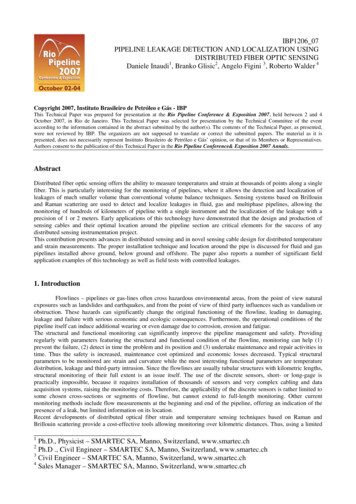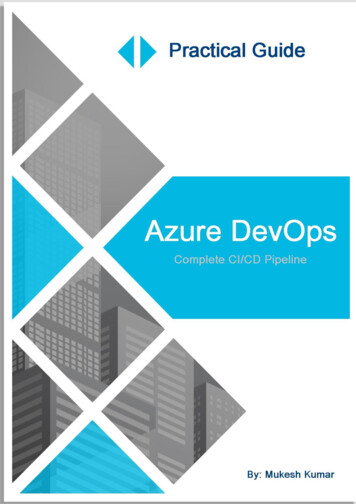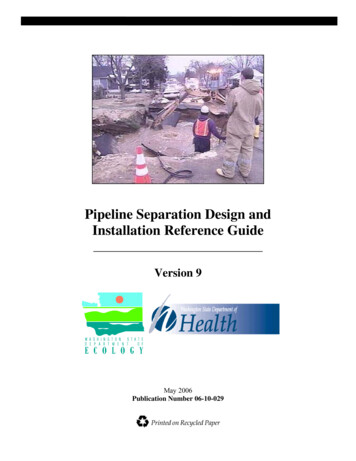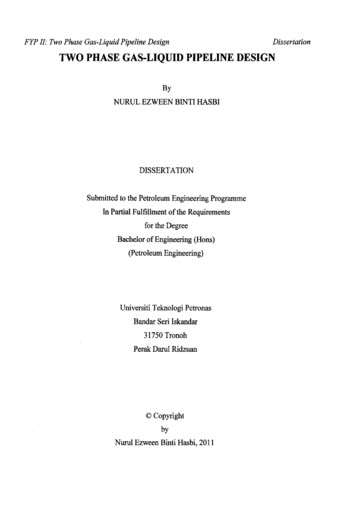
Transcription
A Practical Guide forPipeline ConstructionInspectorsPublished March 2016 2016 CEPA Foundation Inc. and INGAA Foundation Inc.
Page 2 of 131
ACKNOWLEDGEMENTSThis document was developed through the generous and continual support of all CEPAFoundation and INGAA Foundation members.CEPA Foundation Executive Director:Kim McCaig, MBA (CEPA Foundation)CEPA Foundation Body of Knowledge Subcommittee:David Montemurro (TransCanada Corp.)CEPA Foundation Pipeline Inspector Certification Committee Chair:Jason Landa (JSG Professional Services ULC, a Johnson Service Group Company)CEPA Foundation Certification Subcommittee:Andy Duncan, P.Eng. (Enbridge Inc.)INGAA Foundation Executive Director:Richard Hoffmann, MSCE (INGAA Foundation)INGAA Foundation Sponsor & Subcommittee Chair for Pipeline Inspector Certification:David Montemurro (TransCanada Corp.)INGAA Foundation Certification Subcommittee Chair:Andy Duncan, P.Eng. (Enbridge Inc.)INGAA Foundation Subcommittee Chair for Development of A Practical Guide for PipelineConstruction Inspectors:Pierre Bigras, P.Eng. (Pacific Gas and Electric Company)Working Group Members:Thomas Anderson (Henkels & McCoy, Inc.)Pierre Bigras, P.Eng. (Pacific Gas and Electric Company)Scott Culley (CDI Corp.)Victor R. Flores Jr., P.E. (Enable Midstream Partners, LP)Bryon D. Gaskin (Spectra Energy Corp.)Jason Landa (JSG Professional Services ULC, a Johnson Service Group Company)Roger Lemieux (TransCanada Corp.)Kirk Peterman (Energy Transfer Partners, LP)Joseph Prine (The Williams Companies, Inc.)Andy Purves, P.Eng. (Stantec Inc.)Ritch Rappel, MBA (Enbridge Inc.)Bill Watts, P.Eng. (Alliance Pipeline Ltd.)In collaboration with PBoK Technical Training Ltd.:Simon van LeeuwenReena Sahney, P.Eng.Annie SioPage 3 of 131
Page 4 of 131
Table of ContentsACKNOWLEDGEMENTS. 31.0Introduction . 92.0Purpose . 93.0Scope . 94.0Revisions to this Document . 105.0How to Use this Document . 106.0Pipeline Construction Inspector – Foundational Information . 116.1Authority . 136.2Code of Conduct. 136.3Worker, Site, and Construction Safety . 146.4Quality, Deficiencies, and Non-conformance Procedures . 156.4.1Escalation Processes . 166.4.2Personal Violations . 166.5Environmental Considerations . 176.6Execution of Work . 186.7Administration of Contractual Obligations . 196.8Records Management . 216.9Personnel Qualifications and Certifications . 226.10Equipment Calibration . 226.11Incident Reporting . 22References – Foundational Information. 237.0Survey . 257.1Overview . 257.2Inputs . 257.3Execution. 257.4Outputs . 26Detailed Checklists – Surveying . 277.5Typical Input Requirements for Survey Inspection . 277.6Best Practice Items for Inspecting Typical Surveying Operations. 287.7Typical Outputs for Survey Inspection . 32References – Survey. 328.0Clearing and Grading . 338.1Overview . 338.2Inputs . 338.3Execution. 33Page 5 of 131
8.4Outputs . 35Detailed Checklists – Clearing and Grading . 368.5Typical Input Requirements for Clearing and Grading Inspection . 368.6Best Practice Items for Inspecting Typical Clearing and Grading Operations . 378.7Typical Outputs for Clearing and Grading Inspection . 43References – Clearing and Grading . 449.0Stockpiling and Stringing . 459.1Overview . 459.2Inputs . 459.3Execution. 459.4Outputs . 46Detailed Checklists – Stockpiling and Stringing . 479.5Typical Inputs for Stringing and Stockpiling Inspection . 479.6Best Practices for Typical Stringing and Stockpiling Inspection . 489.7Typical Outputs for Stockpiling and Stringing Inspection . 52References – Stockpiling and Stringing . 5310.0Field Bending . 5510.1Overview . 5510.2Inputs . 5510.3Execution. 5510.4Outputs . 56Detailed Checklists – Field Bending . 5710.5Typical Input Requirements for Field Bending Inspection . 5710.6Best Practice Items for Inspecting Typical Field Bending Operations. 5810.7Typical Outputs for Field Bending Inspection . 59References – Field Bending . 6011.0Ditching and Excavation . 6111.1Overview . 6111.2Inputs . 6111.3Execution. 6211.4Outputs . 63Detailed Checklists – Ditching and Excavation . 6411.5Typical Input Requirements for Ditching and Excavation Inspection . 6411.6Best Practice Items for Inspecting Typical Ditching and Excavation Operations . 6511.7Typical Outputs for Ditching and Excavation Inspection. 70References – Ditching and Excavation . 70Page 6 of 131
12.0Welding . 7112.1Overview . 7112.2Inputs . 7112.3Execution. 7112.4Outputs . 72Detailed Checklists – Welding . 7312.5Typical Input Requirements for Welding Inspection . 7312.6Best Practice Items for Inspecting Typical Welding Operations . 7412.7Typical Outputs for Welding Inspection . 75References – Welding . 7613.0Coating . 7713.1Overview . 7713.2Inputs . 7713.3Execution. 7713.4Outputs . 78Detailed Checklists – Coating . 7913.5Typical Input Requirements for Coating Inspection . 7913.6Best Practice Items for Inspecting Typical Coating Operations . 8013.7Typical Outputs for Coating Inspection . 82References – Coating . 8314.0Lowering-In . 8514.1Overview . 8514.2Inputs . 8514.3Execution. 8514.4Outputs . 86Detailed Checklists – Lowering-In . 8714.5Typical Inputs for Lowering-In Inspection . 8714.6Best Practice Items for Inspecting Typical Lowering-In Operations . 8814.7Typical Outputs for Lowering-In Inspection . 92References – Lowering-In . 9215.0Backfilling. 9315.1Overview . 9315.2Inputs . 9315.3Execution. 9315.4Outputs . 94Detailed Checklists – Backfilling . 9515.5Typical Inputs for Backfilling Inspection . 95Page 7 of 131
15.6Best Practice Items for Inspecting Typical Backfilling Operations . 9615.7Typical Outputs for Backfilling Inspection. 101References – Backfilling . 10216.0Cathodic Protection . 10316.1Overview . 10316.2Inputs . 10316.3Execution. 10316.4Outputs . 104Detailed Checklists – Cathodic Protection . 10516.5Typical Input Requirements for Cathodic Protection Inspection . 10516.6Best Practice Items for Inspecting Typical Cathodic Protection Operations . 10616.7Typical Outputs for Cathodic Protection Inspection . 108References – Cathodic Protection . 10917.0Hydrostatic Testing . 11117.1Overview . 11117.2Inputs . 11117.3Execution. 11117.4Outputs . 113Detailed Checklists – Hydrostatic Testing . 11417.5Typical Input Requirements for Hydrostatic Testing Inspection . 11417.6Best Practice Items for Inspecting Typical Hydrostatic Testing Operations . 11617.7Typical Outputs for Hydrostatic Testing Inspection . 122References – Hydrostatic Testing . 12218.0Clean-up and Restoration . 12318.1Overview . 12318.2Inputs . 12318.3Execution. 12318.4Outputs . 124Detailed Checklists – Clean-up and Restoration . 12518.5Typical Input Requirements for Clean-up and Restoration Inspection . 12518.6Best Practice Items for Inspecting Typical Clean-up and Restoration Operations12618.7Typical Outputs for Clean-up and Restoration Inspection Reporting . 130References – Clean-up and Restoration . 130ENDNOTE. 131Page 8 of 131
1.0INTRODUCTIONThis guide provides the details related to the role of the Owner Company’s PipelineConstruction Inspector (“Inspector”), in terms of monitoring and inspection requirementsthroughout the lifecycle of the pipeline construction process. This document is written toaddress general inspection duties. Areas of specialty inspection are noted and arebeyond the scope of this document.This document represents best practices basedconsensus amongst the majority of memberrequirements, both in Canada and the U.S.,competencies and related tasks beyond thosecertification.on the accumulated experience andcompanies in terms of technicalfor pipeline construction inspectioncaptured in regulation and currentWith the anticipated increase in upcoming pipeline construction activity, the CEPA(Canadian Energy Pipeline Association) and INGAA Foundations have established aPipeline Inspector Certification Working Group as part of meeting a number of keyobjectives that include: Introducing a fundamental step change in the training and qualification of PipelineConstruction Inspectors as a means of improving the construction quality ofprojectsImproving the overall quality of work performed by Pipeline ConstructionInspectors within the industryThis document, in particular, is intended to support some of these broader objectives byestablishing a meaningful reference tool to enhance learning for the PipelineConstruction Inspector as a complement to the existing industry knowledge base anddocumentation (such as recognition and alignment with the American Petroleum InstituteRecommended Practice for Basic Inspection Requirements — New Pipeline Construction(API 1169), Canadian Welding Bureau (CWB), American Welding Society (AWS), andNACE International).2.0PURPOSEThe purpose of this document is to provide Pipeline Construction Inspectors withbackground and context, beyond existing regulation, regarding best practices in theindustry. As such, this document is not intended to replace formal training, regulation, orCompany specific practices (which may vary based on individual circumstances); rather,it is intended as a complementary guide to information from those sources.3.0SCOPEThe scope of this document is limited to gas and liquid pipeline construction. Specifically,content is focused on those items that are relevant to the role of a Pipeline ConstructionInspector as it relates to best practices within the industry.Page 9 of 131
4.0REVISIONS TO THIS DOCUMENTThis document will be reviewed periodically (as per existing CEPA and INGAAFoundation practices) to ensure the content within remains relevant and accurate.However, it remains the responsibility of the user to ensure that the most current revisionof documents (e.g., codes and standards) are referenced, where appropriate.5.0HOW TO USE THIS DOCUMENTWith an eye to practicality and ease of use, this document is organized to reflect thetypical construction process for transmission pipelines. Foundational informationcommon to all aspects of construction is presented first, followed by chapters specific toeach phase of construction. Within each chapter, five main headings are usedconsistently: Overview – a brief description of the specific activities in the construction phaseInputs – detailed information regarding typical information the Inspector willrequireExecution – detailed information regarding items the Inspector should typicallywatch for; for ease of use, items are typically formulated as actions using verbssuch as: ensure, monitor, confirm, check, etc.Outputs – detailed information listing typical information the Inspector will berequired to produce for the Owner CompanyReferences – list of key relevant reference documents for those seekingadditional information for each phase of constructionThe “Inputs” section within each chapter is intended to clearly identify the types ofdocuments, specifications, and other information the Inspector would likely need toreference in that phase of construction. The “Execution” section within each chapterprovides detailed checklists, often grouped by major topic, identifying critical items thatInspectors should monitor in that construction phase. Finally, the “Output” section withineach chapter then articulates items that the Inspector is expected to produce or report onas it relates to that particular phase of the construction project.The use of the word “ensure” throughout this document is intended to convey thatInspectors “ensure” that the contractor has performed the inspected work properlythrough observing, monitoring, assessing, evaluating, verifying, deciding, resolving,reporting, and documenting to ensure that the project requirements are met.Page 10 of 131
6.0PIPELINE CONSTRUCTION INSPECTOR – FOUNDATIONAL INFORMATIONThe items covered in this chapter are those that are relevant through all phases of thepipeline construction process (see Figure 1). As such, any specific content in otherchapters of this publication is intended to be used in conjunction with the informationprovided within this section. Additional information regarding the pipeline constructionprocess can be found in the INGAA Foundation publication “Building Interstate NaturalGas Transmission Pipelines: A Primer”.The Inspector acts as the Owner Company’s authorized representative for non-financialmatters, continuously observes the Contractor’s progress and monitors all activities intheir assigned areas in accordance with codes and standards; regulatory requirements;Owner Company safety and environmental requirements, drawings, plans, andspecifications; as well as the terms of the construction contract or agreement. TheInspector may also be asked to assist other specialized Inspectors (e.g., WeldingInspector), as directed.In addition to executing specific responsibilities in the following chapters, the Inspectorhas key responsibilities in the main areas identified in Table 1 with additional detailprovided in the corresponding section.Table 1: Main Areas of Inspector Roles and ResponsibilitiesTopic AreaSection NumberAuthoritySection 6.1Code of ConductSection 6.2Worker, Site, and Construction SafetySection 6.3Quality, Deficiencies, and Non-conformance ProceduresSection 6.4Environmental ConsiderationsSection 6.5Execution of WorkSection 6.6Administration of Contractual ObligationsSection 6.7Records ManagementSection 6.8Personnel Qualifications and CertificationsSection 6.9Equipment CalibrationSection 6.10Incident ReportingSection 6.11Page 11 of 131
SurveyClearing & GradingStockpiling & StringingField BendingDitching & odic ProtectionHydrostatic TestingClean-up & RestorationFigure 1: Typical Pipeline Construction PhasesPage 12 of 131
6.1AuthorityThe Inspector on-site is part of a larger Project Team; as such, the Inspectorshould understand their role within the established chain of command andrecognize situations that may need to be escalated in the best interests of theOwner Company. This is important not only for day-to-day operations, butbecomes particularly important in the handling of deficiencies / non-conformancesdiscussed later in this chapter. In particular: 6.2Roles of the Contractor and Inspector will be established beforeperforming the tests or measurements to determine whether the work oran item complies with specifications and permit requirementsIf the Contractor performs tests or measurements unassisted, theInspector should be clear about the level of witnessing required, and makesure that the equipment and instruments used by the Contractor arecorrect and properly calibratedThe Contractor should be aware of the Inspector’s duties and authority (asdefined in Section 6.4) outlining quality, deficiencies, andnon-conformance proceduresThe Inspector has “stop work” authority when there is imminent danger topeople or the environmentCode of ConductAs the Inspector represents the Owner Company, they should always actethically, professionally, objectively, consistently, and honestly when performingthe required roles and responsibilities.More specifically, the actual ethical conduct required from Inspectors is governedby the Owner Company’s Code of Conduct, which typically includes (but is notlimited to) the items identified in Table 2.Table 2: Typical Code of Conduct ConsiderationsDescription Behaving in an Ethical Manner Abide by confidentiality agreements Not accepting gratuities of any kind that may be perceived to affect judgment in the work being performed as anInspector; if gratuities are offered, this information should be reported to the Owner Company Endeavor to be fair, reasonable, and objective towards performing work requirements at all times Do not make assumptions; consult with the Construction Manager / Chief Inspector (or designate) if there areuncertainties in the requirements Accept or reject the work performed by the Contractor based on the quality of the work Comply with all relevant codes, standards, systems, permits, contracts, agreements, specifications, procedures,approved drawings, line lists Document all deviations and when required, escalate in an appropriate manner for approvalProfessional Approach to Work Be knowledgeable of and understand the relevant parts of the construction processPage 13 of 131
Description Be knowledgeable of and understand Owner Company’s standards and specifications Be knowledgeable of and understand relevant industry and government standards Ensure all applicable permits required to execute the work are in place and on-site prior to commencing the work Uphold Owner Company’s industry practices to ensure safety, minimize risk, and avoid hazards in the workplace Comply with Owner Company’s construction timelines and understand Owner Company’s construction schedule,costs, and components of the work Understand the role relative to other Stakeholders in the construction process and engage other expertiseaccordingly Make accurate decisions by being well informed and familiar with all contract documents and design requirements Arrive on site before the Contractor’s crew and remain until after the crew leaves the site for the day Take breaks when the Contractor’s crew takes breaks and remain on site during construction activities that requireinspection Obtain all applicable documents before the start of inspection If questions arise that cannot be answered, seek those that have the authority to resolve Be proactive in problem solving and raise issues/concerns to the attention of the Construction Manager / ChiefInspector (or designate)Positive Image in Representation of Owner Company Behave in a courteous manner Conduct oneself in a respectable manner during off-time hours Show respect through good driving habits on the right of way (ROW) or public roads Check the work area for good housekeeping and tidiness (e.g., equipment and consumables should be correctlyhandled, stored, and maintained)6.3Worker, Site, and Construction SafetyOne of the key roles of the Inspector is to assist the Owner Company in ensuringa safe work environment both for its workers as well as the public. As such, allon-site Inspectors have “stop work” authority should a safety situation arise.In addition to safety items detailed in the following chapters, the Inspector shouldkeep in mind the items identified in Table 3.Table 3: Typical Safety ConsiderationsDescription GeneralEnsure each member of the activity crew understands their role and responsibility with respect to safety in the executionof the workPlan, schedu
requirements, both in Canada and the U.S., for pipeline construction inspection competencies and related tasks beyond those captured inregulation and current certification. With the anticipated increase in upcoming pipeline construction activity, the CEPA (Canadian Energy Pipeline Association) Foundations have established a and INGAA










